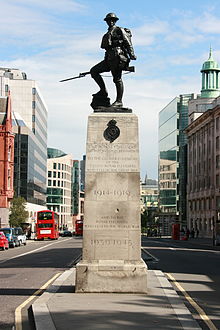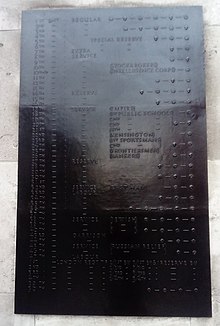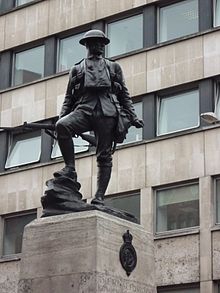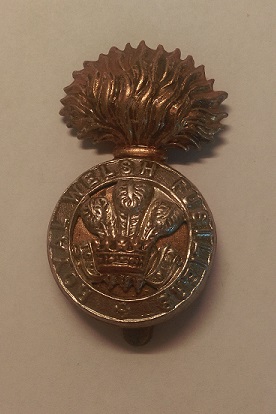
The Royal Welch Fusiliers (Welsh: Ffiwsilwyr Brenhinol Cymreig) was a line infantry regiment of the British Army, and part of the Prince of Wales' Division, that was founded in 1689; shortly after the Glorious Revolution. In 1702, it was designated a fusilier regiment and became the Welch Regiment of Fusiliers; the prefix "Royal" was added in 1713, then confirmed in 1714 when George I named it the Prince of Wales's Own Royal Regiment of Welsh Fusiliers. In 1751, after reforms that standardised the naming and numbering of regiments, it became the 23rd Regiment of Foot (Royal Welsh Fuzileers). In 1881, the final title of the regiment was adopted.
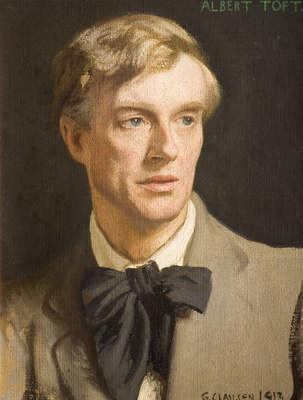
Albert Toft was a British sculptor.
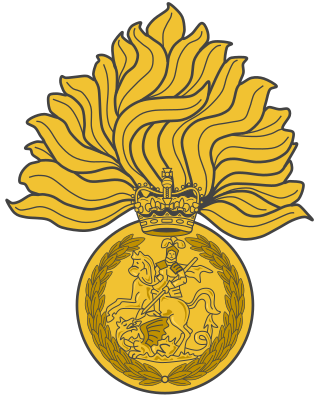
The Royal Regiment of Fusiliers is an infantry regiment of the British Army, part of the Queen's Division. Currently, the regiment has two battalions: the 1st Battalion, part of the Regular Army, is an armoured infantry battalion based in Tidworth, Wiltshire, and the 5th Battalion, part of the Army Reserve, recruits in the traditional fusilier recruiting areas across England. The Royal Regiment of Fusiliers was largely unaffected by the infantry reforms that were announced in December 2004, but under the Army 2020 reduction in the size of the Army, the 2nd Battalion was merged into the first in 2014.

The Royal Fusiliers (City of London Regiment) was a line infantry regiment of the British Army in continuous existence for 283 years. It was known as the 7th Regiment of Foot until the Childers Reforms of 1881.

The Lancashire Fusiliers was a line infantry regiment of the British Army that saw distinguished service through many years and wars, including the Second Boer War, the First and Second World Wars, and had many different titles throughout its 280 years of existence. In 1968 the regiment was amalgamated with the other regiments of the Fusilier Brigade – the Royal Northumberland Fusiliers, Royal Warwickshire Fusiliers and the Royal Fusiliers – to form the current Royal Regiment of Fusiliers.

The Royal Canadian Regiment (RCR) is an infantry regiment of the Canadian Army. The regiment consists of four battalions, three in the Regular Force and one in the primary reserve. The RCR is ranked first in the order of precedence amongst Canadian Army infantry regiments, but in a quirk of the rules of seniority, its 4th battalion is ninth.

The Royal Inniskilling Fusiliers was an Irish line infantry regiment of the British Army in existence from 1881 until 1968. The regiment was formed in 1881 by the amalgamation of the 27th (Inniskilling) Regiment of Foot and the 108th Regiment of Foot.
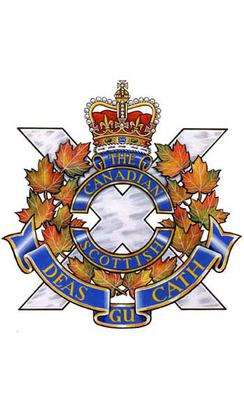
The Canadian Scottish Regiment (Princess Mary's) is a Primary Reserve infantry regiment of the Canadian Army based on Vancouver Island in British Columbia.

The Royal Northumberland Fusiliers was an infantry regiment of the British Army. Raised in 1674 as one of three 'English' units in the Dutch Anglo-Scots Brigade, it accompanied William III to England in the November 1688 Glorious Revolution and became part of the English establishment in 1689.
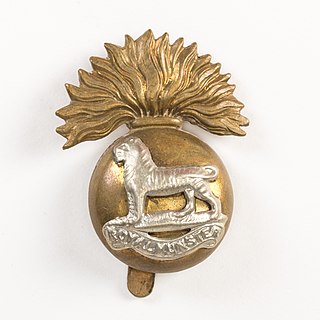
The Royal Munster Fusiliers was a line infantry regiment of the British Army from 1881 to 1922. It traced its origins to the East India Company's Bengal European Regiment raised in 1652, which later became the 101st Regiment of Foot. The Royal Munster Fusiliers were formed in 1881 by the merger of the 101st Regiment of Foot and the 104th Regiment of Foot. One of eight Irish regiments raised largely in Ireland, it had its home depot in Tralee and served as the county regiment for Cork, Clare, Limerick and Kerry. At its formation the regiment comprised two regular and two militia battalions.

The London Troops War Memorial, located in front of the Royal Exchange in the City of London, commemorates the men of London who fought in World War I and World War II.

Oldham War Memorial is a war memorial in Oldham, England, comprising a large bronze sculpture group on a granite plinth. It was built to commemorate the men of Oldham who were killed in the First World War. Bronze plaques on the wall of the churchyard nearby list the fallen, including Mabel Drinkwater, a nurse who died after an operation at Oldham Royal Infirmary. A mechanised roll of honour was added in the 1950s, listing the men from Oldham who were killed in the Second World War. The memorial became a Grade II listed building in 1973. The listing was upgraded to Grade II* in December 2016.

The Cameronians War Memorial is a war memorial in Kelvingrove Park in the west of Glasgow, Scotland, to the north of Kelvingrove Art Gallery and Museum. It commemorates the service of the Cameronians regiment in the First and Second World Wars. The memorial includes a bronze sculpture representing a machine gun emplacement, with three human figures. It became a Category B listed building in 1988.

St Saviour's War Memorial is a war memorial on Borough High Street, in the former parish of Southwark St Saviour, to south of the River Thames in London. It became a Grade II listed building in 1998 and was upgraded to Grade II* in 2018.

The Lancashire Fusiliers War Memorial is a First World War memorial dedicated to members of the Lancashire Fusiliers killed in that conflict. Outside the Fusilier Museum in Bury, Greater Manchester, in North West England, it was unveiled in 1922—on the seventh anniversary of the landing at Cape Helles, part of the Gallipoli Campaign in which the regiment suffered particularly heavy casualties. The memorial was designed by Sir Edwin Lutyens. Lutyens was commissioned in light of a family connection—his father and great uncle were officers in the Lancashire Fusiliers, a fact noted on a plaque nearby. He designed a tall, slender obelisk in Portland stone. The regiment's cap badge is carved near the top on the front and rear, surrounded by a laurel wreath. Further down are inscriptions containing the regiment's motto and a dedication. Two painted stone flags hang from the sides.
The 3rd Battalion, London Regiment was a volunteer unit of the British Army under various titles from 1860 to 1961. Originally raised from railwaymen, the battalion sent a detachment to the Second Boer War and several battalions fought in World War I. Shortly before World War II, it became a searchlight unit and defended the UK during the Blitz, remaining in the air defence role in the postwar Territorial Army.
The 2nd Battalion, London Regiment was a volunteer infantry battalion of the British Army under various titles from 1860 to 1961. It served in Malta, Gallipoli, Egypt and on the Western Front during World War I. In World War II it saw service in Iraq, North Africa and Italy. After a postwar spell as an air defence unit, it reverted to the infantry role, and merged into the Territorials of the Royal Fusiliers.
The 4th Middlesex or Royal South Middlesex Militia was an auxiliary regiment raised in Middlesex in the Home counties of England just before the Crimean War. It later became part of the Royal Fusiliers. Primarily intended for home defence, it served in England and Ireland during Britain's major wars. It was converted to the Special Reserve under the Haldane Reforms and supplied reinforcements to the Royal Fusiliers' fighting battalions during World War I. After a shadowy postwar existence the unit was finally disbanded in 1953.
